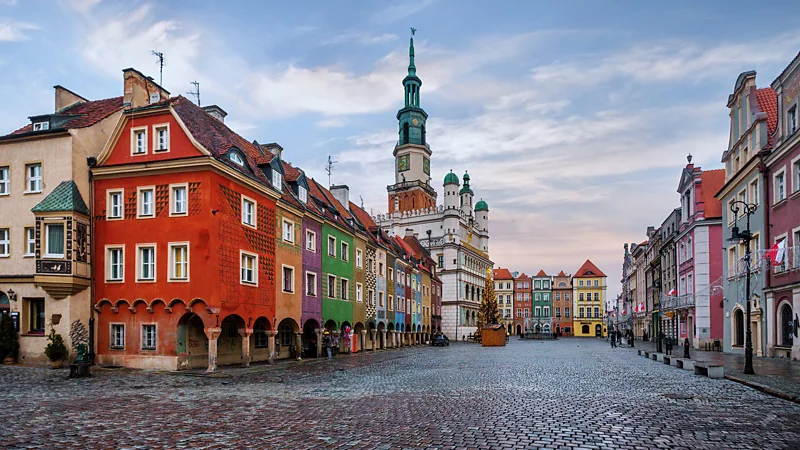The Baltic Express: Central Europe's new hop-on hop-off train
The Baltic Express bursts out of the Czech capital on a crisp winter morning. As the sky lightens, medieval Prague is streamed through the train's windows like a Netflix trailer. From armchair seats in private compartments, a city of Rococo castles and wide boulevards appears: the "Paris of the East", mostly unscathed by Nazi occupation in the 1940s or socialist planning in the 70s. Moments later the train hums through a timeless Czech countryside. Onion-domed churches and frozen fishing lakes scroll past as the train sprints north.

The recently launched route from Prague to Gdynia on Poland's Baltic coast operates four times daily, and takes travellers directly into Central Europe's most vibrant and less-touristed cities that were previously tricky to get to. It will entice international travellers who want to combine a city break with a rural experience, followed by a holiday on the beach.
The term "Baltic Express" is an ambitious misnomer. Think of this new 878km connection not as one of the speedy plane-killer routes trending in recent years – like London to Amsterdam or Istanbul to Ankara – custom-built to compete with budget airlines. Instead, the eight-hour trip promises a scenic history tour through overlapping empires via some of the Czech Republic and Poland's most buzzing cities, including Gdansk and Poznan. Best of all, this highly affordable and experiential journey allows passengers to hop-on and hop-off wherever they choose.
My own journey started in Prague's Hlavní Nádraží station. From outside, the terminus looks like a cathedral to train travel with twin cupolas rising from its roof like Roman temples. The station was built in 1871 when the Austro-Hungarian Empire, which ruled Central Europe, laid train tracks around the empire as a way of weaving all trade and security through the empire's capital of Vienna.
Inside the station, Nádraží Hlavní's main departure hall was decorated when the Czech Republic was part of the Soviet Empire and is a socialist rainbow of primary colours. Yet unbeknown to most passengers, one floor above sits an original waiting room styled in Art Nouveau, while a soaring dome in this higher level overlooks Romanesque statues and polished brass rails. In 2024, the fancy Foyer Café opened in an adjoining salon, serving Czech riesling and viennoiserie pastries high above the hoi polloi. It's a fine way to start a continental meander.
After just one hour aboard the Baltic Express, I make my first hop-off stop at Pardubice. The 100,000-person city exudes Czech charm. The old town square is Prague-esque, with church steeples shaped like space rockets and townhouses coloured every shade of pastel. Pardubice's Austro-Hungarian townhouses are as fancily familiar as in every empire city: Sarajevo, Brno, Lviv. Yet I can count that day's tourists on one hand.
Ironically, statues in Pardubice commemorate the birthplace of Czech aviator Jan Kašpar. In 1911, Kašpar flew south from Pardubice to Prague, following the railway tracks now used by the Baltic Express. The mechanical efficiency of aviation has competed with the romanticism of rail ever since.
I rejoin the Baltic Express an hour before sunset. The topography rises towards the Polish border in an undulating green sheen. First oak woods, feral deer and icy streams. Then pine forests, hunting lodges and deep snows as the train climbs into the quickening night. As Europe has become borderless, only a choral chirp from passengers' cellular networks welcomes our train to Poland.
I share my seating cabin with a woman named Marta Kortas who works in Gdansk's data analytics industry. "The train has made a new connection for me because I have friends in Prague and southern Poland," she tells me. The region of rural Silesia flashes past in the dark, where passengers can get off for thermal springs and salt mines. Kortas lived here during Covid lockdown. "I even dreamt I could move back and use the train to commute to my office a few days per month. Direct connections between Prague, Wroclaw and Poznan makes that dream much easier."
Around 20:00, I alight, alongside Polish business commuters, to spend the night in Wroclaw, Poland's historical third city. For nearly a century before 1945, Wroclaw was the German-speaking city of Breslau, and its Teutonic-Gothic train station was designed by a Prussian architect. After World War Two, however, Poland's borders shifted west and the train station formerly known as Breslau Hauptbahnhof was renamed Wroclaw Glowny – although direct services still run to Berlin on tracks laid by the German Empire more than a century ago.
I wake up to Wroclaw's whirling snow and reboard the Baltic Express for the third time, strolling along the length of the eight-carriage train to gauge the passenger make-up. There are bike racks and bench tables, a dining car and coffee bar, occupied by everyone from Polish grannies to Czech work-from-homers. It's the mix anticipated by Jan Hrabáček of Czech national rail operator České Dráhy, whom I speak to en route.
"We already have a connection from Prague to Budapest and Warsaw," says Hrabáček, who helped develop the Baltic Express route. "So the idea of the Czech and Polish transport ministers was to connect the quickest possible route from Prague and Wroclaw to the sea." Tourism, not business, will be the key summer driver: Czechs used to drive south to Croatia for holidays, says Hrabáček, but now it's expensive. "Czech people 'found' Poland as a destination because the beaches are great and the weather has become warmer."
The joy of the Baltic Express is that it affords a few hours in destinations one might otherwise overlook, like the Czech spa town of Kłodzko or Poland's medieval city of Leszno. I make my penultimate pitstop in Poznan, a Polish cultural capital that has an old town square as pretty as any imagined in a Disney fairytale.
I start in the square's Military Museum, where rakish Napoleonic tunics and dashing air force costumes – Polish soldiers knew how to dress – tell of a darker story. Poland has only enjoyed 50 years of independence in the last two centuries due to Austro-Hungarian, Nazi and Soviet occupiers, which makes the safeguarding of the country's culture during difficult times even more impressive.
For example, the interiors of the Basilica of Our Lady of Perpetual Help look like a darkly atmospheric Vatican with a ceiling as kaleidoscopically intricate as a Fabergé egg. I learn that the Nazis turned the basilica into a warehouse before it was restored after World War Two. Meanwhile, Poznan's magnificent brick brewery, Stary Browar, a city in itself, was mothballed during the Soviet era. It has been reborn as a cultural space and shopping hub near the train station.
At lunchtime, I embark on my final leg towards Gdansk. As a board the train, a conductor I met the day before gives me a nod of welcome. The Baltic Express is starting to feel like home.
The cosiest space is the dining car. A chef grills fresh gołąbki (pork-stuffed cabbage leaves), her assistant spoons out pumpkin barley with kale and the waiter decants bottles of Łomża beer. The train catering company WARS holds a special place in Polish hearts, having catered on international rail routes from Irkutsk to Istanbul since 1948. It's a long way from a British Rail sandwich.
A fellow diner is marketing consultant Karolina Paszkiewicz. "The trains Poland had 10 years ago were slow and cold," she recalls. The train to Gdansk, where Paszkiewicz's clients are based, used to take nine hours from her hometown of Wroclaw. "Today it's four and half," smiles Paszkiewicz, as she munches on a Polish apple pie. "After you've eaten and opened your laptop, it's time to get off."
We're nearly at the end of the line. Outside, the landscape freezes and flattens. A whirl of seagulls intimates that we're descending towards the sea. The natural port of Gdansk has been Poland's window on the world for seven centuries. As a member of the Hanseatic trading league, the port city exported goods around the Baltic Sea between Hamburg, Riga, Bergen and Bremen. Visible from our slowing train are handsome wharf houses where beeswax, amber and furs could be winched up from passing ships.
In Gdansk, history is inescapable. The train terminal is a mirror of Colmar station in France's Alsace region, both designed by German architects when Imperial Germany governed these parts. The city's Museum of the Second World War shares how the first shots of one of Earth's greatest conflicts were fired right here. Finally, the European Solidarity Centre highlights Gdansk's shipworkers' role in helping to bring down Soviet communism decades later.
What makes the Baltic Express special is its sense of interconnectedness. It's a Czech-Polish train, travelling on tracks laid by Austrians and Germans that offers the freedom to eat, sleep and explore en route. Experiential train travel has a new destination.
-BBC







